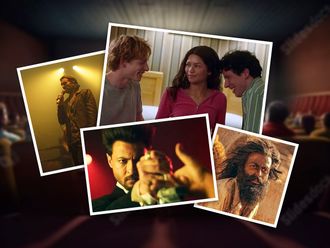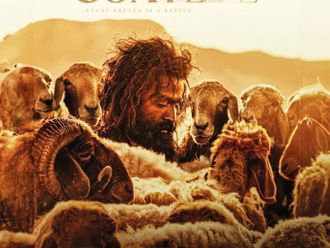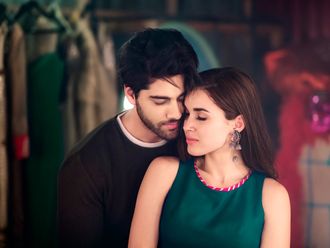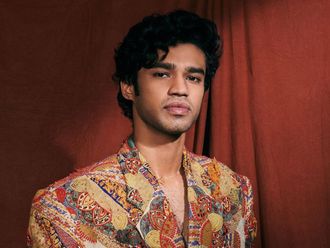On the occasion of its tenth anniversary, Muscat-based Bait Muzna gallery presents Kan Ya Man Kan (Once Upon a Time), an exhibition exploring how the shift from traditional to modern architectural sensibilities and the resultant changes in the urban landscape in the region has altered the lives of its inhabitants and their social structures.
The five featured artistes — Hassan Meer and Budoor Al Riyami (Oman), Camille Zakharia (Lebanon), Manal Al Dowayan (Saudi Arabia) and Anas Al Shaikh (Bahrain) — cogitate on the past and its relationship with the rapidly evolving present and the role of memories in bridging the two through video projections, images and large-scale conceptual photographs.
Zakharia's photographs capture the quotidian of the region's urban landscape. Shot in Bahrain, Qatar and Sharjah, the images capture aspects of the present that are in danger of disappearing any moment. In Remains of Life — Manama, Bahrain, pastel-hued squares emblazoning a wall represent former rooms of a demolished building; the standing wall therefore becomes a penultimate narrative of the tales of joy and sorrow once lived out here.
Evolution of photography
"When spaces such as these, which were once integral aspects of your surrounding, are destroyed, a part of you that lived with these spaces also dies a little," Zakharia says, delineating the link between the environment and its inhabitants.
His works also encompass the curious situation of a photographer photographing photographs. Referring to Interior of Photography Shop, Sharjah, which features a triad of photographs of two men and a more recent one of a little boy in Arab dress, he says that the images speak to him of evolution of photography itself.
"The first two images are hand-tinted black-and-white photos. They hint at a time when having your photograph taken was an event and thus needed to be celebrated accordingly," he says. And the very act of him photographing these portraits shows that the role of photography has shifted from literal representation in the form of portraiture to social commentary.
He emphasises that the importance of the documentary nature of his photography is as much for present as for future generations, for whom it is a visual record of a certain way of life once upon a time. He hopes that the present generation looks beyond the surface realities of the images to the larger picture of their immediate surroundings, which threatens to be evanescent, and becomes more aware of them.
In The House II, a transparent dish-dasha-clad figure with an obscured face lingers in a room with collapsed ceilings and walls, the floor carpeted in rubble: Is it a ghost haunting the ruins of a place once inhabited and dearly loved? Hassan Meer recounts the time when he visited his grandfather's old house after many years and unlocked it to find it in a state of decay. Meer comments that the house represents a cultural crossroad in Omani history what with the discovery of oil and Renaissance resulting in social changes, leading people to migrate from old homes to new ones. The decline of his grandfather's house, which was once inhabited and reverberated with life and gaiety, represents both the destruction of the physical space and that of the memories contained within it.
Hassan abstracts elements from his heritage to fashion a modern response in the Moon series, which refers to photographs taken during the 1970s in Oman in which the act of being photographed was a meticulously conceived process, not unlike contemporary conceptual photography that Meer himself pursues. "Young women would be photographed in the photo studio, sitting atop a crescent moon, for instance, realising their fanciful dreams," he says. Using old photographs of people in these studios, Meer recreated both the moon and studio and photographed a young lady in a stance similar to that of the past, thus creating ersatz antique photographs. Furthermore, what with text being evidently an integral visual layer to all his works, the photograph is overlaid with an 19th century Arabic script particular to Oman. The work is contemporary and yet undeniably of the past, the various strands of Omani history converging.
Unshackling traditions
The monochromatic images of Manal Al Dowayan eloquently speak of the past in the form of traditions: The index finger of a henna-patterned hand points above in Pointing to the Future while hennaed hands pluck the strings of the oud, a traditional Arab instrument, in Silent Song. "I have always questioned the impact of [restrictive] tradition on the advancement of Arab women," she says. "As our societies rapidly develop to keep up with the changing world, people cling to certain traditions for a sense of safety. [However] if traditions are used as a tool to suppress and control, our communities will become handicapped."
In reference to the omnipresent hennaed hands in her images, Al Dowayan says henna is a traditional symbol of beauty but it can also be perceived as regressive in certain contexts. The goal then becomes the unshackling of tradition from its fixed position and using it to enrich, rather than inhibit, women's lives in modern times. The henna-patterned hand appears to say so in Pointing to the Future.
Similarly, in Silent Music, the title is understandably apt considering that we are in the act of viewing the person making music, rather than listening to it; and while we can undoubtedly imagine hearing the song, the song per se is ultimately silent. "This image is about hearing women's voices," she says. "We exist in society but lack a voice … what is the purpose of a musical instrument if you cannot hear it played?" Al Dowayan's stoic black-and-white images urge us to listen to these voices nevertheless, making us aware of their potential for heralding change in contemporary times.
Priyanka Sacheti is an independent writer based in Muscat, Oman.
Kan Ya Ma Kan (Once Upon A Time) is on at the Bait Muzna gallery in Muscat until February 25.












